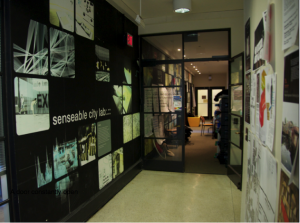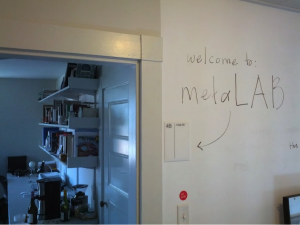Luca Simeone (http://www.luca.simeone.name), PhD in Interaction Design, with a focus on design management and design anthropology, presented on the results of ethnographic investigations conducted over a 3-year period (2011-2014). As the abstract for the seminar explained, “This 50% dissertation presents a compilation of 4 papers that investigate three academic labs – MEDEA at Malmö University, MIT SENSEable City Lab and metaLAB (at) Harvard – that use design to foster collaboration with multiple stakeholders (industry, government, NGOs, citizens, …). More specifically – using concepts such as ‘multi-sited’ from anthropology, ‘boundary organization’ from organizational studies and ‘strategic ambiguity’ from organisational communication – this study adopts different interpretive perspectives to describe the organizational approaches of the three labs and how they use design as way to set up and sustain collaboration with multiple stakeholders.”
In giving an overview of each of the four papers, Simeone drew out several key findings and potential topics for discussion. These included
- orientation and interplay: in what ways organisational components influence and get influenced by the design-based collaborative dimension of the labs
- open versus curated forms of opening production in the “hackathon” setting
- strategic ambiguity as management practice: paradoxical horizontal (small, independent teams) and vertical (hierarchical) structures of a lab like the SENSEable City Lab, ambiguity in engagement roles and communication
- multi-sited design activities: questions of what happens where in multi-sited, geographically distributed design environments
- whether to pursue a monograph or compilation dissertation format
As discussant for the seminar, Joachim Halse (Assistant Professor, The Danish Design School) began by addressing the question of how values such as sharing, freedom and openness are performed and made productive in relation to the pressures in hackathon settings for collaboration with market forces. Halse asked for a more overtly stated point of view on this point. Simeone put forward the concept of academic entrepreneurship as a concept that suggests ways of co-creating values in external communities with multiple perspectives. This would partly involve defining more clearly what a collaborative process is.
Halse then took up the discussion of strategic ambiguity in management process, pointing out that how an individual or group perceives ambiguity will depend on their individual point of view, and that such individual positions, potential differences and/or controversies would be interesting to see further empirical details on so as to get a more nuanced perspective on this management style. Question as to what the implications for power relations in this framework of strategic ambiguity? Behind such ambiguous, seemingly rule-less, bottom-up/horizontal styles of management there might be enacted a certain internalisation of the work ethics that is not necessarily in the style of a reward system. Elucidating sanctions, non take-up of ideas, frustrations, etc. Concept of governmentality could be fruitful here (e.g. Foucault, and as developed further by Nicholas Rose). Luca agreed that there is an invisible layer operating in such environments, pointing out also how design communities he has been in contact with don’t necessarily respond well to concepts of organisational culture. Halse accepted that culture is heavily contested but one can distinguish between culture as an analytic concept that is not out there and its popular, empirical usage (e.g. “it’s my culture”), thus avoiding reification.
Picking up on the research on multi-sitedness, Halse asked what specifically the implications were for design. Luca sees a need for an understanding of how design outcomes travel from one location to another. Organisational protocols are often what tie these multi-sited design activities together, so could have a cultural “recipe” or branding that facilitates this. Geographic locations clearly not neutral and contribute to power dynamics. Halse pointed out that there is probably a methodological way in which one could draw out these nodes in the network. Conventional idea of a design studio is one bounded by walls. Books like Laboratory Life (Latour and Wollgar) show how laboratory boundaries are very porous and multi-sited. Addressing the questions of what is a designer without a singular, located studio in this new multi-sited world and how defining a characteristic is this multi-sited nature of design studies today? Perhaps this multi-sitedness of design activity is a dominant or emerging paradigm.
Q&A
Q: Challenging the discourse some more. Looking at labs as a part of the post-industrial economy. Political economy question could be a fundamental and overarching part within a monograph structure for the dissertation. How does the discourse work for those who are involved? Has the current lab culture had a fundamentally positive impact on the economy compared with previous lab cultures? Seeing beyond the hype. Also, finding out where production takes place via shadowing researchers. Micro ethnographic and anthropological approaches to really pin down the spatial aspects of the multi-sitedness discussed.
Luca: A monograph format for the dissertation might allow better scope for such challenges to the discourses.
Q: No such thing as a perfectly distanced, free critique. The “gatekeepers” in these labs are themselves studying elites capable and can be understood as collaborators in producing knowledge for this research. Finding the balance with various partners.
Q: How do you see yourself answering question of “How is this an interaction design dissertation?”
Luca: Working on reflections of interplay between organisational management and interaction design. Organisational perspective can be helpful for interaction designer to know. Interaction design as a field is expanding to include things like social interaction, this research might be seen as contributing to such an expansion.
Q: How do you see your overall trajectory? What is it designers do when they say they “design”?
Luca: Would like to stay in academia. Have a background in managing design practice and getting more into design management. A contribution to design management community could be to try to look beyond business/economic outcomes and helping to foster dialogic conversational processes, to extend the players that design management researchers take into consideration. Potentially writing for multiple audiences.


